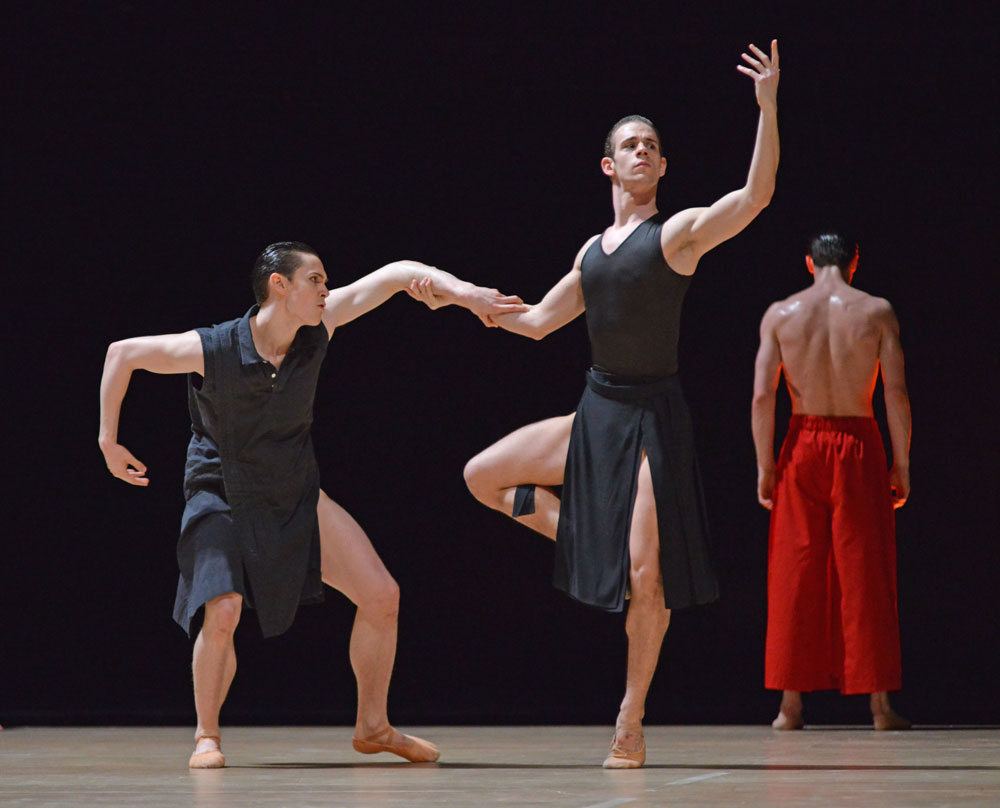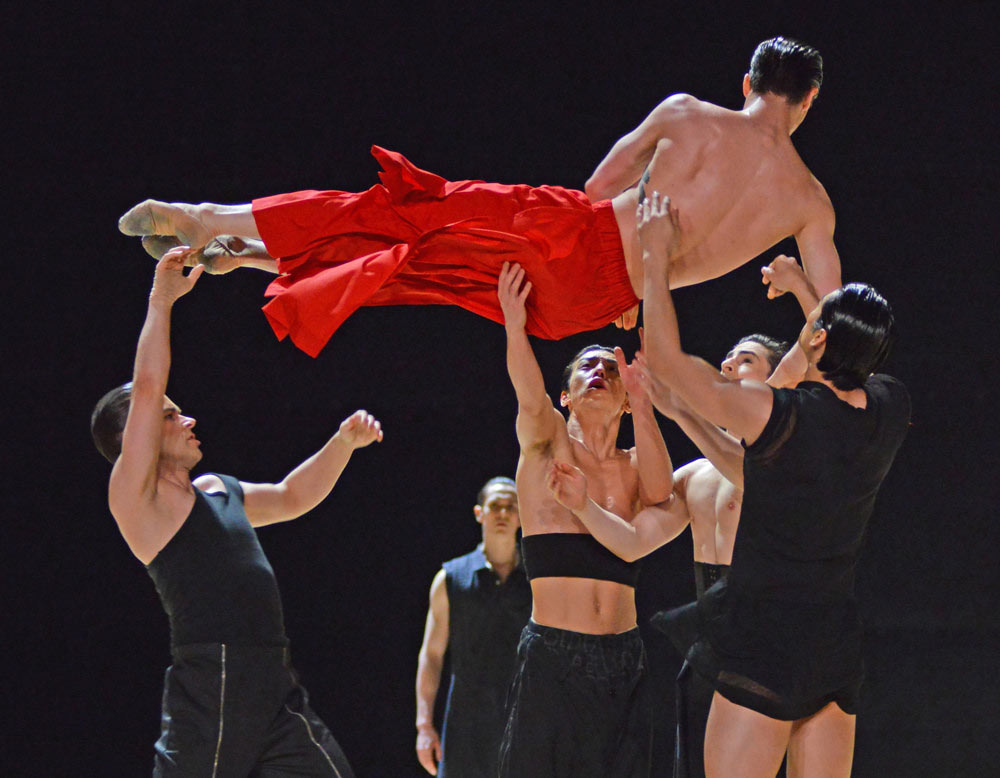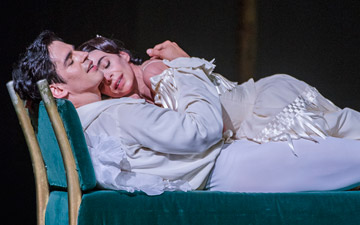
© Tristram Kenton (2017), courtesy the Royal Opera House. (Click image for larger version)
Royal Ballet
Obsidian Tear, Marguerite and Armand, Elite Syncopations
★★★★✰
London, Royal Opera House
14 April 2018
Gallery of pictures by Dave Morgan
www.roh.org.uk
The ostensible link between the three works in this mixed bill is that they are by the Royal Ballet’s resident choreographers, past and present: Frederick Ashton. Kenneth MacMillan and Wayne McGregor. Since none is typical of the choreographers’ work, they reveal little about the expanding repertoire since 1963, when Ashton devised Marguerite and Armand as a pièce d’occasion for Margot Fonteyn and Rudolf Nureyev.
From 2000, when Sylvie Guillem took on Fonteyn’s role, the extravagant ballet has become an international vehicle for star dancers – mostly mature ballerinas and charismatic younger men. The Royal Ballet offers four different casts in this latest revival, starting with Alessandra Ferri and Federico Bonelli, who danced it together last year.

© Tristram Kenton (2017), courtesy the Royal Opera House. (Click image for larger version)
Bonelli has the advantage of currently performing Des Grieux’s adagio solos in MacMillan’s Manon, so the frequent arabesques Ashton included for Nureyev hold no terrors for him. Bonelli’s Italianate good looks complement Ferri’s fragile beauty, soon to turn feverishly gaunt as Marguerite expires from consumption. Ferri has the advantage of a weightless physique that seemingly hasn’t altered since her youth, and exquisitely arched feet, finer than Fonteyn’s. Her stuttering ‘coughs’ on pointe are imbued with pathos, as delicate as her fingers stroking Armand’s face.
Bonelli shows similar tenderness as he closes her eyes at the end, full of remorse. He regretted his humiliating treatment of her as soon as he’d hurled her to the floor. Christopher Saunders as Armand’s stern father is rather too sympathetic, unlike Gary Avis’s duke, an arrogant protector very like Monsieur G.M. in Manon. (No wonder Ashton early on rejected the proposal that he should undertake the story of Manon Lescaut as a ballet: he’d already encapsulated it.)
MacMillan created Elite Syncopations as light relief after his three-act Manon, turning to ragtime music by Scott Joplin and others – very trendy in the 1970s. He carried on breaking taboos: smoking and lounging on stage, provocative bottom-wiggling by usually refined ballerinas, comic turns from danseurs nobles, barely recognisable in Ian Spurling’s zany lycra costumes.

© Dave Morgan, courtesy the Royal Opera House. (Click image for larger version)
Sarah Lamb is deliciously sly in her gleaming white stars and stripes, partnered by gigolo Ryoichi Hirano. Melissa Hamilton remains gamely oblivious to Paul Kay’s attempts to cope with her long legs; James Hay struts and bounds spectacularly in ‘Friday Night’. No one, though, can equal the chutzpah with which Precious Adams (English National Ballet) performed the ‘Calliope Rag’ when dancers from other British companies joined the MacMillan 25th anniversary tribute last year.
The first revival of Wayne McGregor’s Obsidian Tear, which opens the programme, lacks the impact of its premiere in 2016. Then, Edward Watson dominated the ritual proceedings of an assembly of nine men as their high priest. William Bracewell is less compelling, so the mini-dramas among the cast lose focus. The long build-up to the sacrifices at the end becomes baffling for anyone whose view of the entire stage is restricted. Sightlines in the ROH are less than ideal, as McGregor, credited with designing the set, should know.

The first ten minutes, to Esa-Pekka Salonen’s Lachen Verlernt for solo violin, played by Vasko Vassilev, are given over to a duet for two men: Calvin Richardson and Matthew Ball, reprising their original roles. Richardson, in red trousers, appears the neophyte, being initiated by Ball, in black trousers. Though the power play between them shifts, Ball is the one who clicks his fingers near the start (during a hushed passage by the violin) and ends with his hand commandingly on Richardson’s shoulder.
Their bare torsos torque and undulate as they weave around each other, arms extravagant but rarely touching. Richardson is bold enough to place a foot on Ball’s back, setting off a phase of running and lunging to the pulsating violin. McGregor’s choreography uses their legs for propulsion, more martial arts than dancing.

© Dave Morgan, courtesy the Royal Opera House. (Click image for larger version)
As the orchestra begins Salonen’s symphonic poem, Nyx, Ball introduces Richardson into the group of black-clad men – male Wilis? Their outfits have been contributed by fashion designers, credited in the cast sheet. Richardson’s red trousers (by Craig Green) make him conspicuous. He is bullied by Paul Kay (shorts by Julius) and ganged up on by the others – Ball seems to have abandoned his role as protector. They pair up, excluding Richardson, semaphoring at each other. Bracewell and Tomas Mock (kilt by Gareth Pugh) perform an erotic duet with balletic lifts, originally danced by Watson and Eric Underwood, to startling effect. McGregor is examining the flexibility, sensuality and strength of men partnering men. And their brutality.
Outsider Richardson is branded with a slash of black across his chest. As Salonen’s music grows ever more turbulent, a strip of orange perspex across the front of the stage glows like the rim of a volcano. Bracewell stalks across it and orders Ball to drop Richardson into the crater at the back. Distraught, Ball joins him.

Some four pages of programme notes by dramaturg Uzma Hameed set out to explain the mythology and metaphors that inspired Salonen’s Nyx and the title of the ballet. McGregor keeps his options open, so tear can be taken to mean rip or black volcanic glass, obsidian, in the shape of a teardrop: all very obfuscating for a narrative much like The Rite of Spring. McGregor has developed a muscular movement language for his tribe of men, very different from his angular, hyper-extended choreography for women on pointe. Will it take him in a new direction? Ball and Richardson serve him well. He has lost two of the most interesting members of his original cast, Watson and Underwood: youngsters need to develop fast to match them.

















Parry is such a wonderful writer. Even when I don’t agree with her I admire her points. This review is a masterpiece on every level. Brava.